Benchmark DAC1
- 02 Mar 2005 16:14
- 1037

Benchmark Media Systems, Inc., 5925 Court Street Road, Syracuse, NY 13206-1707. Voice: (315) 437-6300. Fax: (315) 437-8119. E-mail: sales@benchmarkmedia.com. Web: www.benchmarkmedia.com. DAC1 2-channel 24-bit 192-kHz digital-to-analog converter, $975.00 (direct from factory). Tested sample on loan from manufacturer.
Standalone digital-to-analog converters make sense only if they are significantly better than the DACs built into typical integrated players. This one is. It is made by professionals for professionals, for reference-quality playback in studio control rooms and mastering rooms, although it is perfectly suitable for audiophile use. What it clearly does not aspire to is audiophile bragging rights based on price and tweako/weirdo features. The cloud-cuckoo-land high-end DACs at ten times and fifteen times the Benchmark’s price are no better and in most cases not as good. Their owners may delude themselves with fantasies of ineffable sonic superiority, but in reality the only fact-based brag they are entitled to is that they paid more than the poor peasants with Benchmark DAC1’s.
Why can I confidently make that statement? Because I measured the DAC1 up and down and sideways with the Audio Precision SYS-2722, possibly the most sensitive and accurate audio-test instrument in the world, and found it to be as nearly perfect as a digital-to-analog converter can get at the present state of the art. Totally perfect 24-bit converters, with the theoretical noise floor of –146.24 dBFS and a perfect monotonicity “staircase” waveform at the ten lowest LSBs, do not yet exist, at any price, and probably never will. Still, the DAC1 yielded the best measurement figures that I have ever obtained out of a digital processor on my test bench, nor have I ever seen better measurements on other units in other publications. Of course, those who believe that the best-sounding electronic components are not the ones that measure best will pooh-pooh the Benchmark. At this point I’m too old to get upset by these audio cultists, any more than I am by the advocates of crystal power or creationism. The fact is that Benchmark designed the DAC1 on the Audio Precision, as witnessed by the 15 AP graphs in the instruction manual; the whole design is obviously measurement-driven. That the audible performance tracks the measurable performance is a given.
The Design
No circuit schematic was available for the DAC1, and in view of the stunning measurements none was really necessary for evaluation. What I do know, from various sources, is that the basic architecture of the circuit is very similar to the one described by Robert W. Adams of Analog Devices in his article on clock jitter in Issue No. 21 of The Audio Critic, published more than ten years ago. The heart of the circuit is a second-generation asynchronous sample-rate converter, a refinement of the original ASRC discussed in the article, followed by a stereo 24-bit/192-kHz multibit-sigma-delta DAC. These Analog Devices chips are the latest-and-greatest, state-of-the-art ICs. Further discussion of the DAC1’s technology would get me into deeper technical waters than I wish to wade through (is that a mixed metaphor?), but I must mention that the unit incorporates Benchmark’s ultralow-distortion HPA2 headphone amplifier. No separate analog input is provided for the HPA2, so I did not test it separately, since its performance would have been conflated with that of the D-to-A circuit itself. Basically, it makes no difference which output of the DAC1 you measure; the results will be virtually the same. The chassis of the DAC1 is a very elegant little black box, no bigger than a smallish book and weighing only 3½ pounds. The front panel has various indicator lights, a switch for the digital inputs, two identical headphone jacks, and a gain control that makes it possible to feed a stereo power amplifier directly, without the need for a preamplifier—most unusual and very useful. The rear panel has three digital inputs—coaxial, optical, and XLR (professional)—and two pairs of analog outputs—balanced (XLR) and unbalanced (RCA). An output level switch toggles between calibrated, off, and variable settings. In the calibrated setting, two 10-turn trimmer pots are accessible through tiny holes for fixing the left and right output levels. They have a range of 20 dB. The complement of inputs, outputs, and controls covers the requirements of the most advanced professional applications, as well as just about any audiophile hookup.
The Measurements
The Benchmark DAC1 accepts any digital input up to 24 bits word length and 192 kHz sampling rate. For these measurements, my Audio Precision settings, insofar as they had any influence on the readings, were 24 bits and 96 kHz, unless otherwise specified.
Most measurement protocols start with the frequency response, which in the case of the DAC1 is so flat that I won’t even bother to reproduce the graph. The response in both channels is ±0.01 dB from 10 Hz to 6 kHz, –0.2 dB at 20 kHz, –0.5 dB at 30 kHz, –0.9 dB at 40 kHz, and –4.5 dB at 48 kHz. That’s easy to visualize.
Perhaps the most revealing measurement of a digital-to-analog converter is THD + N across the frequency spectrum, shown in Fig. 1. Most publications don’t show this curve because it is in the majority of cases a little embarrassing. Above 7 kHz or so the curves aren’t particularly meaningful because of the 22 kHz measurement filter, but below that frequency the –105.5 to –107 dB readings are astonishing, especially since they were taken at –3 dBFS to duplicate the graph in the instruction manual and can therefore be extrapolated to –108.5/–110 dB for the full-scale output. (That 3 dB below full scale is a kind of safety guard band, which is actually unnecessary in the case of the DAC1.) The graph in the instruction manual is even a couple of dB better, perhaps because I wasn’t terribly careful about cabling, fluorescent lights, etc. As it is, –110 dB is equivalent to 0.0003% and that’s far below anything I’ve ever measured or even heard of.
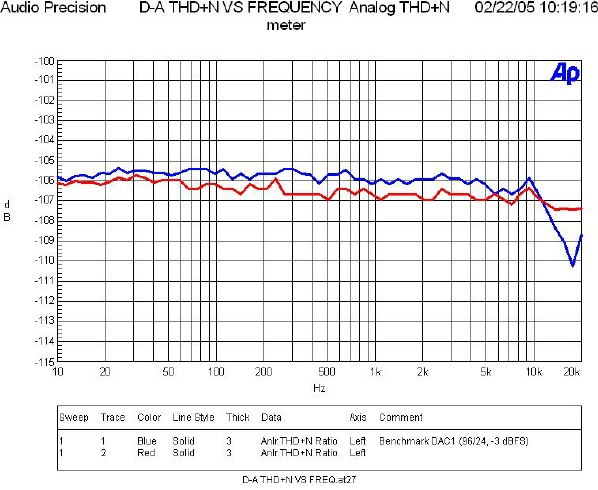
Fig. 1: THD + N @ –3 dBFS, left channel blue, right channel red.
Perhaps the most sensitive distortion/noise test is what I used to call the Rob Watts Test (named after Rob Watts, a U.K. engineer), consisting of the FFT spectrum of a dithered 1 kHz tone at –60 dBFS. This is shown for one channel of the DAC1 in Fig. 2. The largest blip sticking out of a bin-by-bin noise floor of –146 dB is no taller than –134 dB. (Is that clean enough for you?)
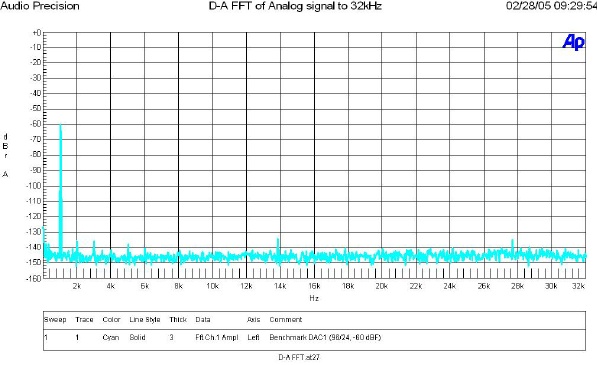
Fig. 2: Spectrum of a dithered 1 kHz tone @ –60 dBFS in one channel.
I also measured the single-point noise figure, which came to –112.4 dB in both channels. The SNR of a theoretical 19-bit digital system is 116.14 dB, so according to this measurement the DAC1 is about “18½ bits clean.” Even 16-bits-clean equipment is rare.
Intermodulation distortion at full scale, with the most punishing test frequencies of 19 kHz and 20 kHz, is shown in Fig. 3. The sidebands are below –105 dB; all other spurious frequencies are below –114 dB.

Fig. 3: IMD at full scale, 19 kHz + 20 kHz, in one channel.
Crosstalk at full scale is shown in Fig. 4. The graph speaks for itself; I have never seen better channel separation in any piece of audio equipment.
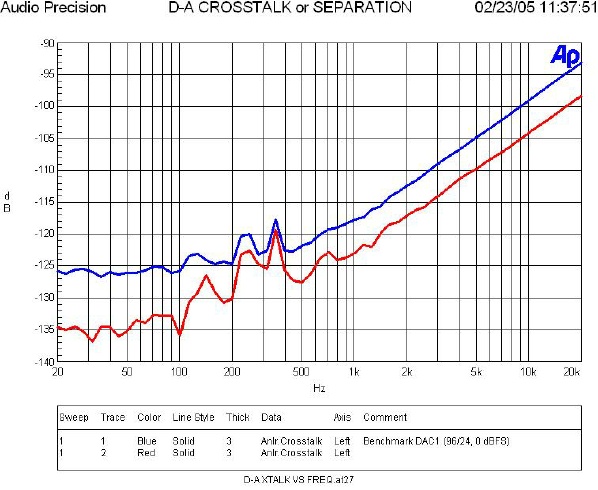
Fig. 4: Crosstalk @ 0 dBFS, left channel blue, right channel red.
Gain linearity error is –0.15 dB at the –90 dB level and –0.5 dB at the –100 dB level, reaching a maximum of –1.25 dB at –108 dB. Errors that small would be hardly visible on a graph with lower resolution than Fig. 5.
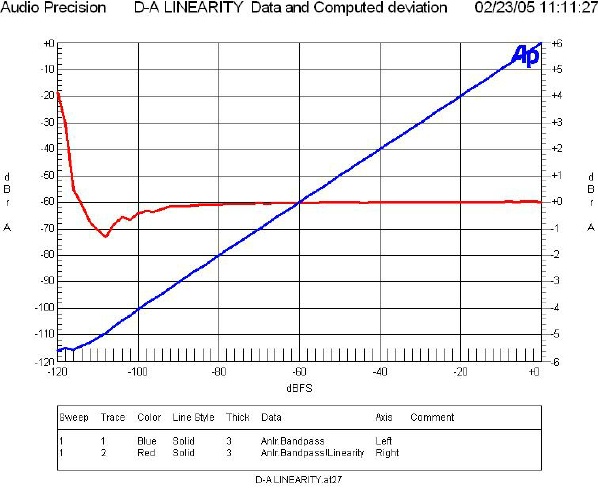
Fig. 5: Gain linearity (blue) and deviation from linearity (red) in one channel.
As for low-level linearity pushed to the ragged edge, there’s the dreaded monotonicity waveform, available as a special setting of the digital generator on the Audio Precision SYS-2722. I specified 24 bits, 192 kHz sampling, and 10 samples/step for the monotonicity test. Thus the square-wave half-period was 10/192,000 seconds, or 52.1 microseconds (corresponding to a full square wave frequency of 9.6 kHz); each equal-amplitude section was ten half-periods long, or 0.521 ms; and each eleven-step repetition occurred at a rate of 11×0.521 ms, or every 5.21 ms. As Fig. 6 shows, no 24-bit DAC in the world is perfect, not even the Benchmark, but the envelope still narrows gradually from left to right and there is still the suggestion of a staircase. (I must admit it took a lot of averaging to get even that far.)
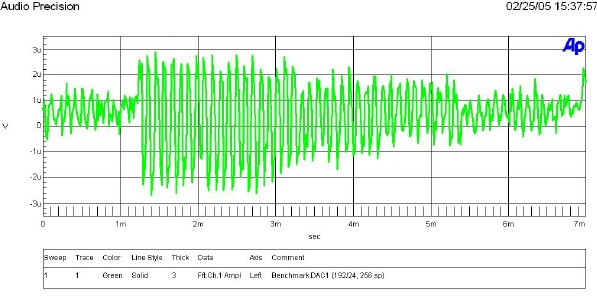
Fig. 6: Monotonicity waveform, 24-bit resolution, 10 samples/step, 192 kHz sample rate.
A word about jitter. Some high-end reviewers flap their wings very vigorously on the subject, but as Bob Adams pointed out more than ten years ago in the abovementioned article, there is no reason to single out distortion components caused by jitter as distinct from those caused by other circuit mechanisms. Distortion is distortion, no matter where it comes from, and the tests above cover that ground in sufficient detail. To isolate and measure jitter, one would have to remove the cover and go inside the Benchmark DAC1, because it doesn’t have a digital output (nor does it need one). The instruction manual goes into great detail about jitter, with four different graphs to prove the DAC1’s immunity to it. Just for the hell of it, without much hope of significant results, I ran a hi-rez FFT of a full-scale 20 kHz tone to see if there were any noise sidebands in its vicinity that would indirectly indicate the presence of jitter. As Fig. 7 shows, there weren’t any, at least not under the conditions of my quickie test. And that’s all, folks.

Fig. 7: Spectrum of a full-scale 20 kHz tone, 8 kHz to 32 kHz, one channel.
The Sound
It should be obvious from the above discussion, at least to those familiar with The Audio Critic, that the Benchmark DAC1 has no sound of its own, transparently passing on to its output the quality of its input. Whatever sonic peculiarities may perchance be audible are due to the input signal, not the DAC1 circuit. Even if the circuit were a lot less perfect, that would still be the case. Absolute sonic transparency is a concept innocent audiophiles are uncomfortable with, believing that all audio components—CD players, preamplifiers, amplifiers, tuners, all of them—exhibit varying degrees of soundstaging, front-to-back depth, grain, air, etc. That it isn’t so, except in the case of loudspeakers, is a fact calmly accepted by professional engineers but not by the high-end pundits and high-end manufacturers, who would be out of business if the truth were to sink in universally.
I am by now a little tired of harping on this subject but was still amused by John Atkinson’s comments on the Benchmark DAC1 in the May 2004 issue of Stereophile. John made sure to tell his readers that the Mark Levinson No. 30.6, which cost $17,500 before it was discontinued, still sounds better than the Benchmark, despite the latter’s perfect measurements. In a December 2004 followup (“2004 Editor’s Choice,” namely the Benchmark!) he adds the Theta Generation VIII ($10,000) and the Wadia 27ix ($9959) to the of-course-sounds-better list. I wonder what quality the Mark Levinson, Theta, and Wadia engineers dial into their products—above and beyond flat frequency response, low distortion, low noise, and the other usual suspects—that mysteriously makes them sound better. Maybe I should stop wondering after 28 years as an audio journalist and 57 years as an audiophile.
Now that I got that off my chest I need to add that I actually listened (yes!) to the DAC1 in a no-preamplifier hookup. The digital output of my CD player was plugged directly into the DAC1’s coaxial input and its unbalanced outputs were plugged directly into the electronic crossover of the Linkwitz Lab “Orion” speakers. The sound, needless to say, was mind-blowing (for lack of a better word), but mostly because of the quality of the speakers, though admittedly aided by the total absence of electronic distortion. I would gladly have set up a double-blind listening comparison of the CD player’s analog outputs versus the DAC1, but then I realized that it would be an apples-and-oranges situation. Red-book 16-bit/44.1-kHz PCM against a 24-bit/192-kHz converter? It’s not very meaningful. I’d have to scare up a late-model DVD-Audio player for a valid ABX test. I’ll do it, soon, but you know something? I don’t think I’ll hear a difference. Even so, I’ll take electronic perfection, any day of the week, if it costs $975 instead of $17,500.
---Peter Aczel
